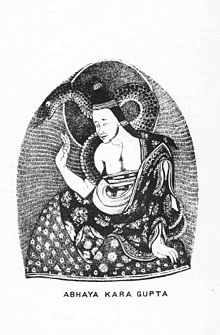Abhayakaragupta

Abhayākaragupta (
Abhayākaragupta's magnum opus, the Vajravali, is a "grand synthesis of tantric liturgy" which developed a single harmonized tantric ritual system which could be applied to all
According to A.K. Warder, Abhayākaragupta developed the
Overview
Some Tibetan sources identify his birthplace as Jarikhanda which Taranatha places next to Odisha. Gudrun Bühnemann identifies this as modern-day Jharkhand around the Chota Nagpur Plateau.[7]
As a youth he went to the country of
Abhayākaragupta's prolific scholarship extended from Mahayana doctrine and philosophy to Tantric Buddhist ritual and practice. David Seyfort Ruegg, writing about one of his main scholarly works writes:
The Munimatalamkara is one of the last of the major comprehensive treatises of Indian Buddhism, and it presents a treatment of Mahayanist thought based on the
Yogacara traditions. Although as such it is not in the narrowest sense a work of the Madhyamaka, it bears testimony to the efforts made by the later Madhyamikas systematically to elaborate a synthesis of the entire Mahayanist tradition.[11]
The Munimatalamkara survives in Tibetan, and it was widely studied in Tibet until the 14th century when it was displaced by native treatises on similar subjects.[12]
Another major text by Abhayākaragupta is the great Tantric work, the Vajravalimandopayika which is a systematic exposition of
The mandala and other rituals taught by the teacher have been divided into two classes (yogatantra and yoginitantra). We shall summarize them here as clearly and as systematically as possible. Moreover, the ritual treatises compiled by (other) preceptors (acarya) lack completeness, thematic core, lucid expression and sometimes authenticity and consistency. Therefore, we shall adorn it with all such good qualities.[17]
Abhaya composed this work by selecting mandala systems and rituals from different tantric traditions and texts, and attempting to strike a balance between the
His other Tantric works expound in detail on particular practices in the Vajravali; the Niṣpannayogāvalī (Garland of Completed Yogas), contains detailed descriptions of the drawing of 26 mandalas while the Jyotirmañjari details the practice of fire rituals recommended in the Vajravali.[14]
Tibet
Abhayākaragupta's school of Buddhism flourished in India until the invasions of the Turks in the 13th century killed or scattered them; but his teachings were continued and revered in Tibet. Through his works at Vikramasila, he exerted great influence on the formation of Tibetan Buddhism, particularly during the twelfth through fourteenth centuries.[19]
In the lineage of the
Works
Abhayakaragupta was a prolific scholar who wrote many works in Sanskrit and also translated sadhana texts into Tibetan. The Tibetan canon lists 27 works by him including:
- Vajravalimandopayika, a treatise on Buddhist Tantra
- Amnaya-mañjari, a commentary on the Samputatantra
- Marmakaumudī ('Moonlight of Points'), commentary on the Perfection of Wisdom Sutra in Eight Thousand Lines.
- Ocean of Means of Achievement (Tib. sgrub thabs rgya mtsho)
- Munimatālaṃkāra ('Ornament to the Subduer's Thought', Tib. thub pa'i dgongs rgyan), an encyclopedic Mahayana treatise based on Maitreya's Abhisamayalankara.[22]
- Niṣpannayogāvalī (Garland of Completed Yogas), a text which explains how to draw 26 kinds of mandalas.[2]
- Jyotirmañjari, discusses fire ritual (homa)
- Kālacakrāvatāra (Introduction to the Wheel of Time)
- Upadeshamañjari, explicates the generation stage and completion stage.
Footnotes
- ISBN 9780691157863.
- ^ a b Nakamura, Hajime. (1980) Indian Buddhism: A Survey with Biographical Notes. 1st Indian Edition (1987), Motilal Barnasidass, Delhi, p. 335.
- ^ Warder, A. K. (1970) Indian Buddhism. 2nd revised edition: Motilal Banarsidass, Delhi. (1970), p. 485.
- ^ Yong-Hyun Lee, Synthesizing a Liturgical Heritage: Abhayākaragupta's Vajravali and the Kalacakramandala
- ^ Warder, A. K. (1970) Indian Buddhism. 2nd revised edition: Motilal Banarsidass, Delhi. (1970), p. 505.
- ^ Kapstein, Matthew. Reason's Traces Identity and Interpretation in Indian and Tibetan Buddhist Thought, Wisdom Pubs. Boston, page 393
- JSTOR 43379879.
- ^ Das, Sarat Chandra. Contributions on the Religion and History of Tibet (1970), p. 91. Manjushri Publishing House, New Delhi. First published in the Journal of the Asiatic Society of Bengal, Vol. LI (1882).
- ^ Warder, A. K. (1970) Indian Buddhism. 2nd revised edition: Motilal Banarsidass, Delhi. (1970), p. 485.
- ^ Das, Sarat Chandra. Contributions on the Religion and History of Tibet (1970), p. 92. Manjushri Publishing House, New Delhi. First published in the Journal of the Asiatic Society of Bengal, Vol. LI (1882).
- ^ Ruegg, David Seyfort. The Literature of the Madhyamaka School of Philosophy in India, Otto Harrassowitz • Wiesbaden, 1981, Volume VII, page 114.
- ^ Kapstein, Matthew. Reason's Traces Identity and Interpretation in Indian and Tibetan Buddhist Thought, Wisdom Pubs. Boston, page 394
- ^ Arnold, Edward A. (editor.) As Long as Space Endures: Essays on the Kalacakra Tantra in Honor of H.H. the Dalai Lama, 2009, page 415
- ^ a b Tadeusz Skorupski. Jyotirmañjari of Abhayåkaragupta. The Buddhist Forum , Volume VI,The Institute of Buddhist StudiesTring, UK, 2001, 183-221
- ^ a b Yong-Hyun Lee, Synthesizing a Liturgical Heritage: Abhayākaragupta's Vajravali and the Kalacakramandala, 2003, p. 5.
- ^ Yong-Hyun Lee, Synthesizing a Liturgical Heritage: Abhayākaragupta's Vajravali and the Kalacakramandala, 2003, p. 1.
- ^ Yong-Hyun Lee, Synthesizing a Liturgical Heritage: Abhayākaragupta's Vajravali and the Kalacakramandala, 2003, p. 67-68.
- ^ Yong-Hyun Lee, Synthesizing a Liturgical Heritage: Abhayākaragupta's Vajravali and the Kalacakramandala, 2003, p. 68-69.
- ^ Kapstein, Matthew. Reason's Traces Identity and Interpretation in Indian and Tibetan Buddhist Thought, Wisdom Pubs. Boston, page 393
- ISBN 0-8047-0901-7(pb).
- ^ Das, Sarat Chandra. Contributions on the Religion and History of Tibet (1970), pp. 81-103. Manjushri Publishing House, New Delhi. First published in the Journal of the Asiatic Society of Bengal, Vol. LI (1882).
- ISBN 0-86171-151-3.
